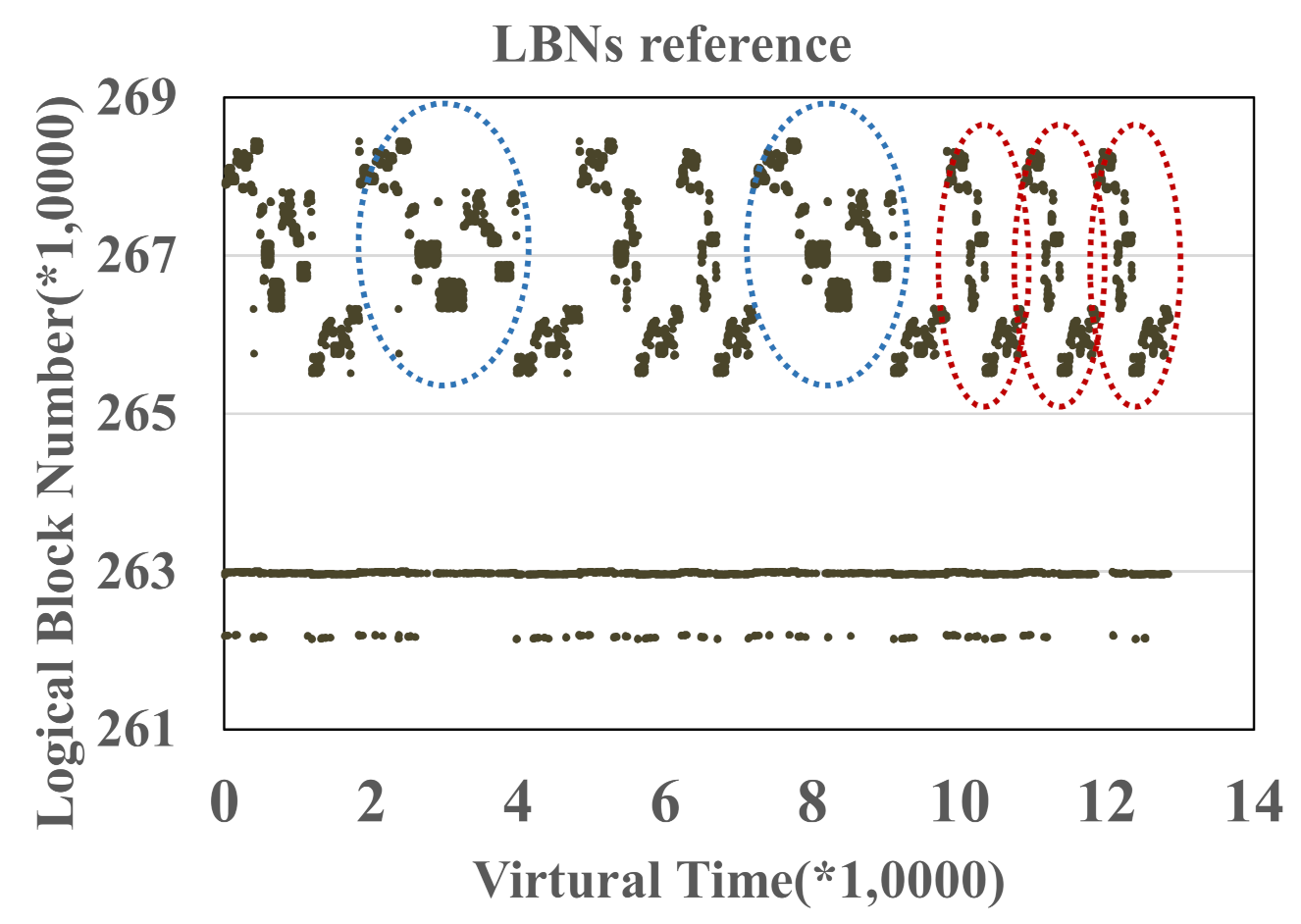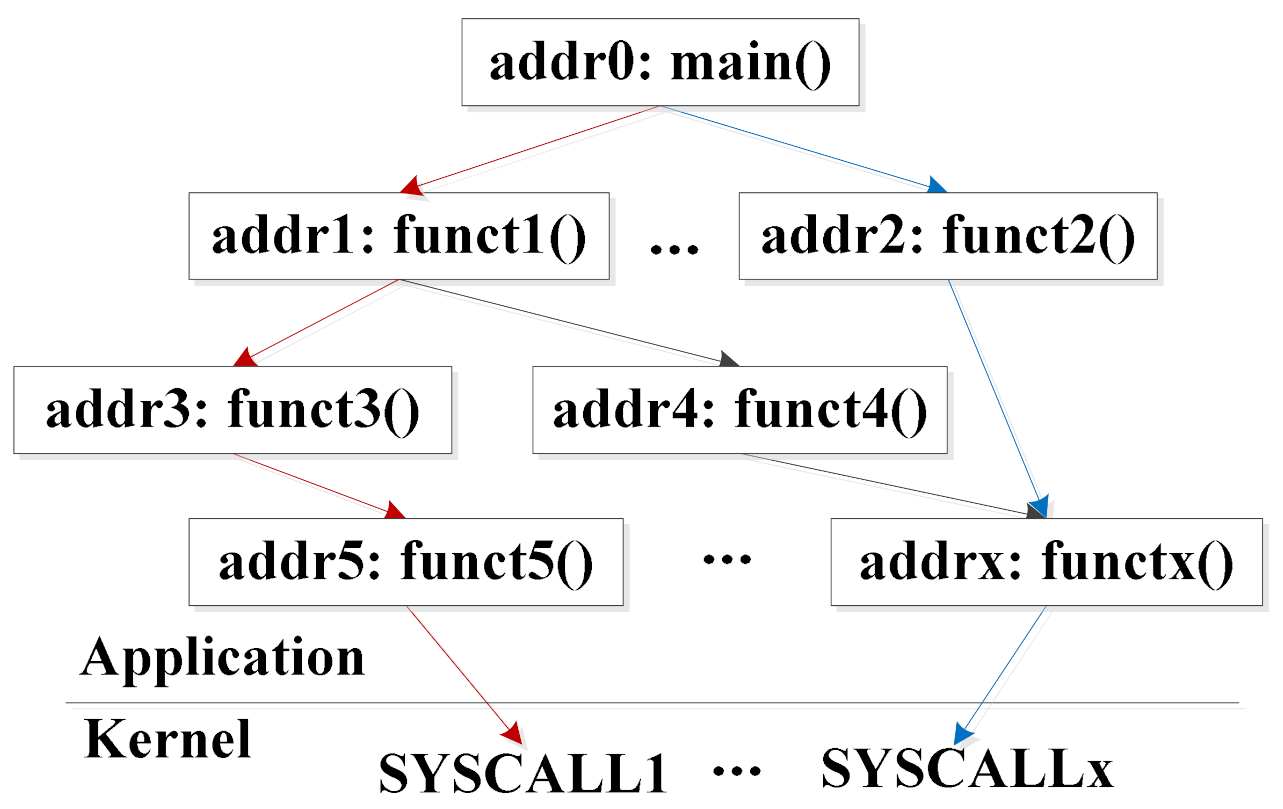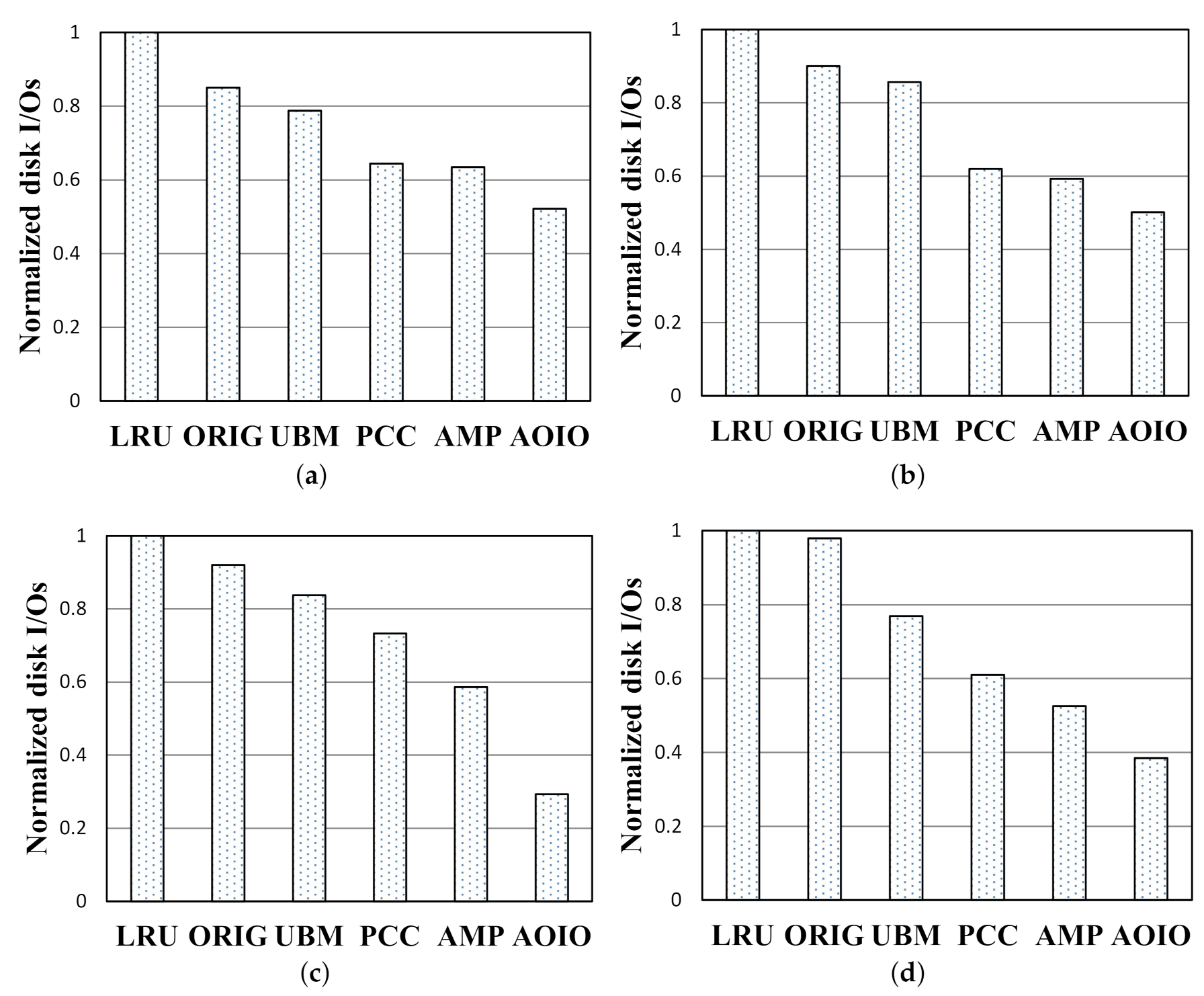AOIO: Application Oriented I/O Optimization for Buffer Management
Abstract
:1. Introduction
- New finer-grained I/O patterns are proposed in our article, and therefore, the kernel can deal with different kinds of data patterns by corresponding optimal policies.
- Basing on the hints from patterns, we design and implement a new buffer manager, AOIO, co-existing with Linux buffer manager.
- When applications are managed by AOIO, the managements for target applications are independent of the original buffer management scheme in operating systems, which can insulate and significantly improve the performance of selected applications.
- The experimental results prove that AOIO provides a more accurate prediction of I/O patterns than traditional buffer schemes, and AOIO can outperform state-of-the-art schemes.
2. Background
- Frequency or recency-based buffer management schemes, called LRU-based schemes.
- User-level buffer management schemes based on application hints.
- Program counters based buffer management by making blocks statistics in file systems.
3. Motivation
4. Design of AOIO
4.1. PC Calculator
4.2. Pattern Classifier
4.3. Buffer Commander
5. Performance Evaluation
5.1. Experimental Setup
5.2. Performance Comparison Results
6. Conclusions
Author Contributions
Funding
Data Availability Statement
Conflicts of Interest
References
- Sivarajah, U.; Kamal, M.M.; Irani, Z.; Weerakkody, V. Critical analysis of Big Data challenges and analytical methods. J. Bus. Res. 2017, 70, 263–286. [Google Scholar] [CrossRef] [Green Version]
- Chen, C.P.; Zhang, C.Y. Data-intensive applications, challenges, techniques and technologies: A survey on Big Data. Inf. Sci. 2014, 275, 314–347. [Google Scholar] [CrossRef]
- Zhang, Y.; Swanson, S. A study of application performance with non-volatile main memory. In Proceedings of the 2015 31st IEEE Symposium on Mass Storage Systems and Technologies (MSST), Santa Clara, CA, USA, 30 May–5 June 2015; pp. 1–10. [Google Scholar]
- Kim, J.M.; Choi, J.; Kim, J.; Noh, S.H.; Min, S.L.; Cho, Y.; Kim, C.S. A low-overhead high-performance unified buffer management scheme that exploits sequential and looping references. In Proceedings of the 4th Conference on Symposium on Operating System Design & Implementation, San Diego, CA, USA, 22–25 October 2000; Volume 4. Available online: https://dl.acm.org/doi/10.5555/1251229.1251238 (accessed on 29 March 2021).
- Jiang, S.; Zhang, X. LIRS: An efficient low inter-reference recency set replacement policy to improve buffer cache performance. ACM SIGMETRICS Perform. Eval. Rev. 2002, 30, 31–42. [Google Scholar] [CrossRef]
- Lee, D.; Choi, J.; Kim, J.H.; Noh, S.H.; Min, S.L.; Cho, Y.; Kim, C.S. LRFU: A spectrum of policies that subsumes the least recently used and least frequently used policies. IEEE Trans. Comput. 2001, 50, 1352–1361. [Google Scholar]
- Megiddo, N.; Modha, D.S. ARC: A Self-Tuning, Low Overhead Replacement Cache. Fast 2003, 3, 115–130. [Google Scholar]
- Ye, X.; Zhai, Z.; Li, X. ZDC: A Zone Data Compression Method for Solid State Drive Based Flash Memory. Symmetry 2020, 12, 623. [Google Scholar] [CrossRef] [Green Version]
- Gniady, C.; Butt, A.R.; Hu, Y.C. Program-counter-based pattern classification in buffer caching. Osdi 2004, 4, 27. [Google Scholar]
- Smith, J.E. A study of branch prediction strategies. In Proceedings of the 25 Years of the International Symposia on Computer Architecture (Selected Papers), Saint-Malo, France, 19–23 June 1998; pp. 202–215. [Google Scholar]
- Bellas, N.; Hajj, I.; Polychronopoulos, C. Using dynamic cache management techniques to reduce energy in a high-performance processor. In Proceedings of the 1999 International Symposium on Low Power Electronics and Design, San Diego, CA, USA, 16–17 August 1999; pp. 64–69. [Google Scholar]
- Powell, M.D.; Agarwal, A.; Vijaykumar, T.; Falsafi, B.; Roy, K. Reducing set-associative cache energy via way-prediction and selective direct-mapping. In Proceedings of the 34th ACM/IEEE International Symposium on Microarchitecture, MICRO-34, Austin, TX, USA, 1–5 December 2001; pp. 54–65. [Google Scholar]
- Lai, A.C.; Falsafi, B. Selective, accurate, and timely self-invalidation using last-touch prediction. In Proceedings of the 27th IEEE International Symposium on Computer Architecture (IEEE Cat. No. RS00201), Vancouver, BC, Canada, 14 June 2000; pp. 139–148. [Google Scholar]
- Lai, A.C.; Fide, C.; Falsafi, B. Dead-block prediction & dead-block correlating prefetchers. In Proceedings of the 28th IEEE Annual International Symposium on Computer Architecture, Goteborg, Sweden, 30 June–4 July 2001; pp. 144–154. [Google Scholar]
- Zhou, F.; von Behren, J.R.; Brewer, E.A. AMP: Program Context Specific Buffer Caching. In Proceedings of the USENIX Annual Technical Conference, General Track, Anaheim, CA, USA, 10–15 April 2005; pp. 371–374. [Google Scholar]
- Ha, K.; Kim, J. A program context-aware data separation technique for reducing garbage collection overhead in NAND flash memory. In Proceedings of the 7th IEEE SNAPI, Denver, CO, USA, 25 May 2011. [Google Scholar]
- Kim, T.; Hong, D.; Hahn, S.S.; Chun, M.; Lee, S.; Hwang, J.; Lee, J.; Kim, J. Fully automatic stream management for multi-streamed ssds using program contexts. In Proceedings of the 17th {USENIX} Conference on File and Storage Technologies ({FAST} 19), Boston, MA, USA, 25–28 February 2019; pp. 295–308. [Google Scholar]
- Pages, L.M. Posix_Fadvise (2)-Linux Man Page. Available online: https://pubs.opengroup.org/onlinepubs/009695399/functions/posix_fadvise.html (accessed on 29 January 2021).
- Robinson, J.T.; Devarakonda, M.V. Data cache management using frequency-based replacement. In Proceedings of the 1990 ACM SIGMETRICS Conference on Measurement and Modeling of Computer Systems, Boulder CO, USA, 21–24 May 1990; pp. 134–142. [Google Scholar]
- O’neil, E.J.; O’neil, P.E.; Weikum, G. The LRU-K page replacement algorithm for database disk buffering. ACM Sigmod Rec. 1993, 22, 297–306. [Google Scholar] [CrossRef]
- Lee, D.; Choi, J.; Kim, J.H.; Noh, S.H.; Min, S.L.; Cho, Y.; Kim, C.S. On the existence of a spectrum of policies that subsumes the least recently used (LRU) and least frequently used (LFU) policies. In Proceedings of the 1999 ACM SIGMETRICS International Conference on Measurement and Modeling of Computer Systems, Atlanta, GA, USA, 1–4 May 1999; pp. 134–143. [Google Scholar]
- Cao, P.; Felten, E.W.; Li, K. Application-Controlled File Caching Policies. In Proceedings of the USENIX Summer, Boston, MA, USA, 6–10 June 1994; pp. 171–182. [Google Scholar]
- Patterson, R.H.; Gibson, G.A.; Ginting, E.; Stodolsky, D.; Zelenka, J. Informed prefetching and caching. In Proceedings of the Fifteenth ACM Symposium on Operating Systems Principles; 1995; pp. 79–95. [Google Scholar]
- Zapata, H.; Perozo, N.; Angulo, W.; Contreras, J. A Hybrid Swarm Algorithm for Collective Construction of 3D Structures. Int. J. Artif. Intell. 2020, 18, 1–18. [Google Scholar]
- Soares, A.; Râbelo, R.; Delbem, A. Optimization based on phylogram analysis. Expert Syst. Appl. 2017, 78, 32–50. [Google Scholar] [CrossRef]
- Choi, J.; Noh, S.H.; Min, S.L.; Cho, Y. Towards application/file-level characterization of block references: A case for fine-grained buffer management. In Proceedings of the 2000 ACM SIGMETRICS International Conference on Measurement and Modeling of Computer Systems, Santa Clara, CA, USA, 18–21 June 2000; pp. 286–295. [Google Scholar]
- Precup, R.E.; David, R.C.; Petriu, E.M.; Szedlak-Stinean, A.I.; Bojan-Dragos, C.A. Grey Wolf Optimizer-Based Approach to the Tuning of Pi-Fuzzy Controllers with a Reduced Process Parametric Sensitivity. IFAC PapersOnLine 2016, 49, 55–60. [Google Scholar] [CrossRef]
- Li, P. Selecting and using virtualization solutions: Our experiences with VMware and VirtualBox. J. Comput. Sci. Coll. 2010, 25, 11–17. [Google Scholar]
- Oh, K.; Park, J.; Eom, Y.I. Weight-Based Page Cache Management Scheme for Enhancing I/O Proportionality of Cgroups. In Proceedings of the 2019 IEEE International Conference on Consumer Electronics (ICCE), Las Vegas, NV, USA, 11–13 January 2019. [Google Scholar]
- Plonka, D.; Gupta, A.; Carder, D. Application Buffer-Cache Management for Performance: Running the World’s Largest MRTG. In Proceedings of the Large Installation System Administration Conference, Dallas, TX, USA, 11–16 November 2007. [Google Scholar]
- Congiu, G.; Grawinkel, M.; Padua, F.; Morse, J.; Brinkmann, A. MERCURY: A Transparent Guided I/O Framework for High Performance I/O Stacks. In Proceedings of the 2017 25th Euromicro International Conference on Parallel, Distributed and Network-Based Processing (PDP), St. Petersburg, Russia, 6–8 March 2017. [Google Scholar]











| Workloads | Applications Run Concurrently | #.of References | # of Unique Pages |
|---|---|---|---|
| Multi1 | gcc, MySQL | 84,109 | 51,687 |
| Multi2 | gcc, RocksDB, mpeg-play, MySQL | 300,016 | 162,746 |
| Multi3 | gunplot, cscope, MySQL | 203,321 | 40,293 |
| Multi4 | postgres, gcc, gunplot, MySQLGraphChi | 3,202,321 | 810,714 |
Publisher’s Note: MDPI stays neutral with regard to jurisdictional claims in published maps and institutional affiliations. |
© 2021 by the authors. Licensee MDPI, Basel, Switzerland. This article is an open access article distributed under the terms and conditions of the Creative Commons Attribution (CC BY) license (http://creativecommons.org/licenses/by/4.0/).
Share and Cite
Li, X.; Zhai, Z.; Ye, X. AOIO: Application Oriented I/O Optimization for Buffer Management. Symmetry 2021, 13, 573. https://doi.org/10.3390/sym13040573
Li X, Zhai Z, Ye X. AOIO: Application Oriented I/O Optimization for Buffer Management. Symmetry. 2021; 13(4):573. https://doi.org/10.3390/sym13040573
Chicago/Turabian StyleLi, Xiaochang, Zhengjun Zhai, and Xin Ye. 2021. "AOIO: Application Oriented I/O Optimization for Buffer Management" Symmetry 13, no. 4: 573. https://doi.org/10.3390/sym13040573





